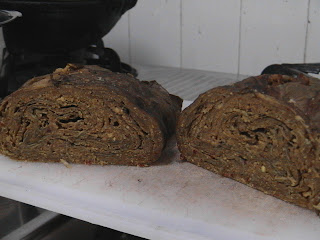We had the colocasia leaves growing in our garden when I was a child. Every once in a while, we'd go through the routine of cutting the leaves, making the masala or massol as it is called in Konkani. H and I would always be assigned the job of destemming the leaves. What fun! More fun because we could play the blame game whenever a leaf was cut or got beaten beyond repair. We would cut the stem by marking a V at the base of the leaf and then string the leaves. After this we would lightly beat the veins using a rounded smooth stone.
I made this when I found colocasia (taro) leaves at the INA market. It is much simpler than I imagined. The result is superb and so the work that goes into it feels like nothing at all.
Ingredients:
7-8 Colocasia (Arbi) Leaves
1/2 cup Rice
1/2 cup Dal
7-8 Red Chillies
1/3 cup Coconut, scraped
1/4 cup Tamarind Paste
1 tsp Turmeric Powder
1 tsp Asafoetida
2 tbsp Jaggery
Salt to taste
For the tempering:
1 tbsp Oil1/4 tsp Mustard Seeds
1/4 tsp Asafoetida
7-8 Curry Leaves
Soak the rice and dal together for at least 4 hours.
Destem the leaves and flatten the veins using a rounded stone.
Grind the rice and dal together along with all the other ingredients except the leaves.
Place the largest leaf on a clean surface, smooth side down and smear the paste over the leaf.

Place the next leaf over this in such a way that the tip of the leaf is near the base of the one below.
Smear the paste over the leaf and place another pointing in the opposite direction and proceed in the same manner until you have used the smallest leaf.

Fold the sides of the leaves inwards and smear more paste. Roll the leaves in a swiss roll like manner and tie with a string.

Steam cook this bundle in a cooker without using the pressure for about 30 minutes. When done, it should look like this.

Cool completely and cut into slices after removing the string.
To proceed, heat the oil in a kadhai. Add the mustard seeds and asafoetida. When the mustard splutters, add the curry leaves. Add the slices of patrodo and fry for a few minutes allowing the slices to crispen.
Amma says that there are variations here. The slices may be deepfried or toasted on a tawa. I like my patrodo with tadka and I love it with rice and dali saar.
You could adjust the tamarind paste int he recipe to suit your taste. The tamarind helps remove the itchiness that these leaves cause. Also, the leaves with purple stems cause less itching than the ones with green stems.
The partodo rolls may be made in advance and frozen. When you are ready to eat them, bring them out from the freezer, thaw them and then proceed. I have yet to make the final dish. Am saving the rolls in my freezer for an evening when I return from NOIDA so tired that all I want to do is eat dali saar and fry patrodo. And believe that all is well with the world.

Rice being the one of the ingredients here, I am also sending this entry to Jihva for ingredients started by Indira of Mahanandi and hosted by Sharmi of Neivedyam.

As this is a Konkani dish, I am sending it to Asha for the RCI Karnataka, an event started by Laksmi that celebrates the regional cuisine of India.














































